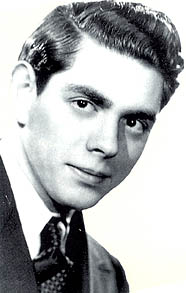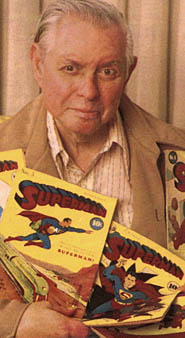 |
Comic strip creator Hal Foster was born in Halifax, raised in Winnipeg and became one of the most famous comic strip illustrators upon moving to the United States at age 28. [The Toronto Star] |
When “Superman” made his debut as a comic strip sensation in 1938, the newspaper employing reporter Clark Kent was The Daily Star. The fictional name was suggested by its first illustrator, Joe Shuster, because, as a paperboy, young Joe had delivered the Toronto Daily Star. By the time the newspaper was named The Daily Planet in 1940, “Superman” had become a super hit across North America.
Shuster, however, was not the first Canadian to illustrate a comic strip. A decade earlier, Harold R. Foster, a native of Halifax, Nova Scotia, working for a Detroit advertising agency, was hired to create realistic illustrations for the Tarzan stories of Edgar Rice Burroughs. His original ten-week trial is “the most reprinted, most imitated and most important Tarzan strip of all.” But Foster is even better known and honoured for his work as author and illustrator of “Prince Valiant,” which premiered one year before “Superman.”
 |
Comic strip creator Hal Foster was born in Halifax, raised in Winnipeg and became one of the most famous comic strip illustrators upon moving to the United States at age 28. [The Toronto Star] |
There is little similarity between the two illustrators who entertained millions of readers for more than half a century. Joe Shuster,a shy introvert with poor eyesight, was born into a family of limited means who had emigrated to Canada from Rotterdam. He often scrounged paper from local shops, being given, on one occasion, rolls of wallpaper left over from a neighbourhood job. “The backs were blank naturally. So it was a gold mine for me, and I went home with every roll I could carry,” he recalled in a1992 interview for The Toronto Star, a paper he had delivered in Toronto when only nine years old. A year later, in 1924, Joe moved to Cleveland with his parents and became a high-school classmate of Jerry Siegel, his later collaborator.
Hal Foster, born in 1892, the son of a seafaring family, was sailing a 30-foot sloop solo at age ten. When the family business failed in 1906, the Fosters moved to Winnipeg where young Hal, besides turning to boxing, enjoyed sketching, hunting, and fishing.
His ability to sketch landed him a job as a staff artist for a mail-order house until the depression of 1913. He then freelanced but, on marrying in 1915, moved to Ontario where he worked as a hunting guide. Foster added prospecting for gold to his skills, struck a “million dollar claim” at Rice Lake, Ontario, in 1917, and worked it for three years before the claim was jumped and passed out of his control.
Foster thought again about art but, with a wife and two children to support, decided he needed to improve his skills if he were to be successful. At age 28, he made a 1,000-mile bicycle trip to Chicago to enroll at the Art Institute. More courses followed at both the National Academy of Design and the Chicago Academy of Fine Arts before he landed a job with a Detroit advertising agency. In 1928 he was introduced to Tarzan author Edgar Rice Burroughs and was commissioned to illustrate a venture new to a newspaper syndicate — a comic strip based on a serious adult adventure story.
The ten-week series drawn by Foster was a success but he had other commitments and gave up the comic strip to another illustrator. In 1931, however, he agreed to do the illustrations for the Sunday colour strip of “Tarzan” and he continued to do so until he stopped in 1937 to write and illustrate “Prince Valiant.”
  |
| DC Comics is the pioneer of the comic book industry and inventor of the Super-hero genre. Its Action Comics, published since June 1938, was made successful by its Superman series. Joe Shuster, shown, right, a year before his death, illustrated Superman numbers 1, 7, 10, 13, 17, 19-24, 83, 88, 97. The younger image of Shuster was taken shortly after he left Toronto for the United States. [The Toronto Star] |
Joe Shuster and Jerry Siegel, meanwhile, were still struggling to make their mark with “Superman.” After leaving high school, they eventually sold, in 1934, their first two stories to DC Comics. One was about a swashbuckling hero called Henry Duval; the other was about a magician, Dr. Occult. The former was illustrated on the back of Toronto wallpaper. The syndicate thought that the concept of Superman was just too far out, one owner claiming the idea “ridiculous.” There were already comicstrip heroes in costume—futuristic characters such as “Flash Gordon” and “Buck Rogers,” but a costumed “man of steel” fighting battles on the planet Earth in the present century was beyond comprehension until Action Comics took a chance in June1938.
The response was incredible! Within months the comic book featuring a Superman adventure was selling more than half a million copies. By 1939, Superman became a comic book in itself, and soon a daily comic strip. In 1940, the Mutual Radio Network began a tri-weekly 15-minute radio serial.
Shuster and Siegel’s creation, however, was not a personal financial success for the two friends. After years of rejection, they finally sold the first 13 pages for a total of $130 or $10 a page, signing the customary release form that, unfortunately for them, relinquished all rights to the character. When they later protested, they were told they were “grossly exaggerating” the importance of “Superman” and that instead they should each put their energies into working “with zest and ambition to improve.”
By 1941 Superman was appearing in 230 newspapers with an estimated circulation of 25 million. There were overseas translations and spin-off products as well that earned some $1.5 million dollars annually. The creators of “Superman” split $150,000 among themselves and a small staff of five artists working in one room in Cleveland! They won a partial court victory in 1947, sharing $100,000 for the newly created character, “Superboy,” but were denied their claim to the ownership of “Superman” and were fired when the contract for the daily comic strip they were producing ran out in 1948. By then, Shuster was no longer illustrating because of his failing eyesight.
By contrast, “Prince Valiant” enabled Foster to take trips to Europe where he carefully studied medieval history to re-create accurately the scenes for his strip which won kudos from historians and teachers alike. In 1946, Eagle Lion Pictures produced a full-length movie starring Robert Wagner. Foster also received awards from several groups including the National Cartoonists Society before he retired fully from the field in 1979. He died three years later at the age of 90.
Shuster and Siegel continued to struggle to gain recognition for their creative effort which continued to enrich DC Comics, but little happened until 1975 when a $20-million-dollar Superman movie was announced. There had been earlier Grade B movies, but this time Siegel wrote and distributed widely a nine-page press release to make Superman fans and comic industry leaders better aware of both his and Shuster’s claim and plight. By then Siegel was working in a mailroom, and Shuster, legally blind, was living with a brother in a Los Angeles suburb.
A peace offering was made by the owners of “Superman.” They gave the partners, in exchange for an end to the feud, an annual pension of $20,000 each as well as life-long medical coverage and a promise, in the event of their deaths, to take care of Siegel’s wife and Shuster’s brother. Their names were also re-instated on the comic strip.
Shuster died in 1993, a year after his interview with the Toronto Star and 52 years from the time of his last visit to the city of his birth where he was best man for still another Canadian achiever, his cousin Frank of Wayne and Shuster fame.